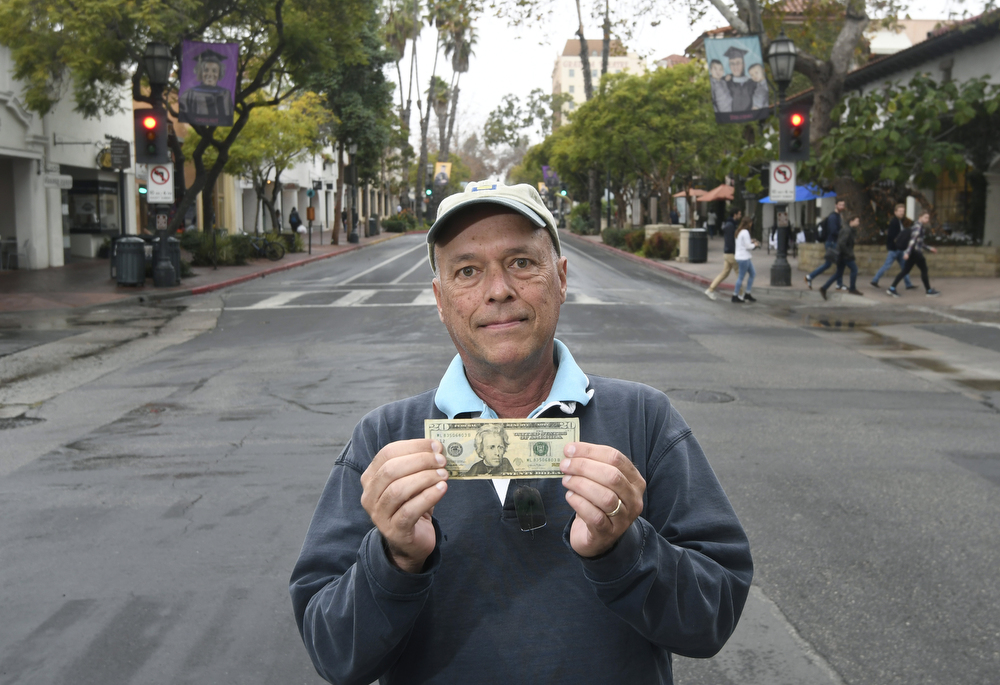‘Cash Mob’ to Descend on State Street
First of 8 Pop-Up Events Will Gather Saturday Afternoon for Serious Retail Therapy

An earth scientist with a penchant for mixing street theater with apocalyptic events, Bruce Caron is now trying to save State Street from its retail “blahs” and post Thomas Fire “blues.” Caron is best known as agitator-in-chief for the controversial Light Blue Line project in 2007 to highlight the impact of climate change on sea level rise. Now, he’s hoping to galvanize a pop-up “cash mob” of about 100 people armed with $20 bills to spend at a downtown Santa Barbara business whose identity will be announced Saturday at Dargan’s at 4:30 p.m. Seven more similar events will kick off at later dates.
Caron said the idea came to him after hearing from the owners of Plum Goods, a locally-sourced, artsy-crafty gift and clothing boutique, how they’d been hammered by small crowds and low sales because of the Thomas Fire. “State Street was an ash-covered ghost town,” Caron said. “For a lot of businesses, this was the time they make about 25 percent of their sales for the year.”
“I asked myself what I could do,” he explained. Then he did what all would-be activists do: checked Google. That’s how he stumbled onto other cash mobs, mostly organized in Rust Belt communities in the Midwest. He’s targeting locally owned stores with “a commitment to the community.” Participants are being asked to spend $20, so it’s important, he said, that the shops sell items priced accordingly. “We’re not asking people to buy $200 shirts,” he added. “Also, they have to sell things that both men and women can buy.”
Caron is ready for action. Dangling from his belt is a bright red re-usable shopping bag balled up and wrapped into itself. His wife, he joked, refers to it as his scrotum. “At the grocery store she’ll say, ‘Honey, did you bring your scrotum?’”
Now 65 years old, Caron graduated from UCSB then studied linguistics and anthropology as a graduate student in Washington, where he said the CIA made a stab at recruiting him. “I got a nice meal out of it,” he said with a laugh. Along the way, he wrote a dissertation on Japanese street theater. Today, Caron works for the Federation of Earth Science Information Partners, a clearinghouse of technical information backed by such agencies as NASA, NOAA, and United States Geological Survey.
In 2007, Caron came up with the idea of painting a light blue line throughout downtown Santa Barbara showing where the sea level would rise if Greenland’s vast ice sheets were to melt. Then-councilmember Helene Schneider — now mayor — took the lead in promoting the idea. When it came out that City Hall would pay the $12,000 it cost to paint the line over a 1,000-foot stretch, the News-Press and the development community went ballistic. They complained the line was more akin to graffiti than public art, that it would damage property values, and that the city’s public review process had been improperly circumvented.
Ultimately, Schneider found a private citizen willing to cough up the $12,000, but when developers notified City Hall they planned to sue, then-Mayor Marty Blum engineered a face-saving retreat. The idea of the light blue line so appalled Frank Hotchkiss, then a private citizen and a skeptic of man-made climate change, that he ran for City Council. Although he lost in his first bid, Hotchkiss would ultimately win and was for a brief historical moment part of the council’s only conservative majority. Hotchkiss ran for mayor this November and lost to fellow councilmember Cathy Murillo. He, like Mayor Helene Schneider and councilmember Bendy White, served their last council meeting last December.
In the meantime, Caron has remained involved in efforts to raise climate change consciousness. “We think a lot about 100-year floods and five-year floods,” he said. “But what about 5,000-year floods?” Events such as these — known as Black Swan Events — are hard to contemplate, much less plan for. “But whoever thought we’d have a 9.0 earthquake and a 40-foot tsunami at the same time in Japan?” he asked, referring to the March 2011 nightmare that triggered the massive nuclear disaster at the Fukushima Diaichi Nuclear Power Plant.
Caron remembers being in Washington, D.C., in 2007 when he got the call from Mayor Marty Blum that she had pulled the plug on the Light Blue Line. But he also remembers being in the City Council chambers last year when the council voted to go “fossil free” by the year 2030. Councilmember Hotchkiss voted against the resolution, saying it would lead to higher energy bills. He also accused proponents of spreading false information. “Back in 2007, when people asked ‘What can we do?’ the only answer was ‘Change your light bulbs,’” Caron said. “Now there’s a lot we can do.” After the council’s “fossil free” vote, Caron said Mayor Schneider approached him and said, “’Hey, it took 10 years, but we did it.’”
Editor’s Note: This story was changed on December 7 to reflect that Hotchkiss is a climate skeptic, not a climate denier.



